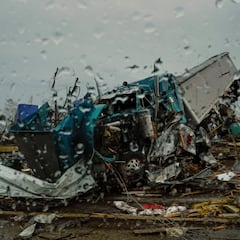What is the storm season in the USA, when does it start and when does it end?
The US by virtue of its location and size is home to some of the worst natural phenomena that Mother Nature can throw at us. Here’s when to expect each one…

The United States is a big country and due to its geography experiences some extreme weather events throughout the year. From sweltering heat in the summer to brutal cold in the winter, each season has its choice of adverse weather conditions.
Also, depending on the time of the year Americans can expect one kind of storm or another throughout the year. Each one brings with it certain kinds of dangers and precautions that should be taken to keep yourself safe.
Here’s a look at when to expect treacherous weather…
When to expect tornados
Some of the most severe weather is associated with the spring as one of Mother Nature’s most powerful and violent phenomena occur, tornados. However, tornados can form anytime of the year, but they are more frequent in certain geographic areas at specific times of the year.
While they occur in many parts of the world, the US is one of the places where they appear the most with an average of around 1,200 annually. Tornados result in around 85 deaths per year and over 1,500 injuries. They mainly occur east of the Rocky Mountains where the concentration of the ideal conditions needed for their formation come together.
We're repeating @NWSHuntsville to have a plan in place and have multiple ways to get warnings during this severe weather event! https://t.co/Agir5aTnZu
— National Weather Service (@NWS) March 31, 2023
Cold dry air from the northwest and dry warm air from the southwest flow out of the mountain regions hitting warm moist air from the Gulf of Mexico creating the storm cells that spawn twisters. This convergence mainly takes place over a section of the US known as “Tornado Alley” spanning from Central Texas through the Plains up to South Dakota. However, the term can be misleading as the frequency of tornados shifts from one geographical area to another during the year. Likewise, the overall frequency in this area has been decreasing while increasing further east according to a study published in Nature.
Generally, the threat of tornados is greater in the Southeast during the cooler months of the year. As temperatures rise the threat moves west with peak tornado season in May and June for the southern and central Plains. The northern Plains and Midwest experience the most activity during early summer.
Tornados can form at any time of day, but are most common between 4 and 9 pm according to the National Severe Storms Laboratory at NOAA.
When is Hurricane season?
While the official hurricane season last for roughly six months going from late spring to late fall, like tornados, hurricanes can form at any time of year. The US has three different hurricane seasons, the Atlantic, Central Pacific and Eastern and each one has specific peaks spanning from July to September.
For those of you who must travel, we recommend taking a winter safety kit with you pic.twitter.com/3fP4x4wXIe
— NWS Medford (@NWSMedford) March 31, 2023
Other storm phenomena to expect in the US?
The winter months bring with them the prime conditions for weather events that can cause severe storms with the potential to have strong winds and heavy precipitation in the form of rain, sleet and/or snow.
Atmospheric rivers
The winter of 2022-23 saw the West Coast get battered again and again by a phenomenon known as an atmospheric river. Also called the “Pineapple Express” in the US, these are most common in the fall and winter, and can bring with them immense amounts of precipitation. As the name suggests, this phenomenon is essentially a river in the sky, composed of water vapor. The volume of which can be the equivalent of 25 times the flow of the Mississippi River at its mouth where it empties into the Gulf of Mexico.
Nor’easter
Related stories
Those that live on the East Coast are familiar with the term “nor’easter”. These storms can occur any time of the year but between September and April are the most frequent and violent. They can form as far south as Georgia but usually gain maximum intensity by the time they reach New England. Nor’easters usually bring gale force winds and heavy precipitation which can result in flooding.
Polar vortex
The frequency and power of nor’easters are becoming stronger as another atmospheric phenomena increases, the polar vortex. This low pressure system is always present over the North and South Poles, made up of extremely cold air. During the winter it expands and strengthens, but sometimes it weakens sending a strong blast of Artic air spilling over the US. When the conditions are right it can result in severe winter storms across the nation.


